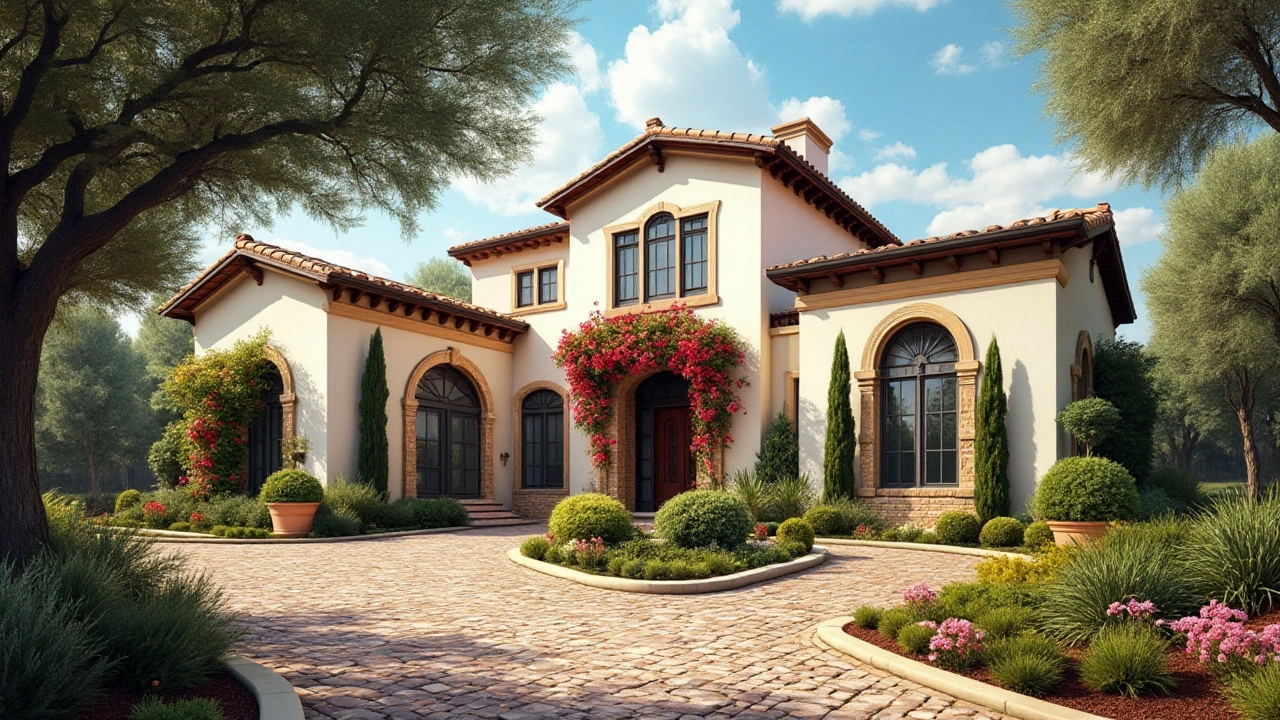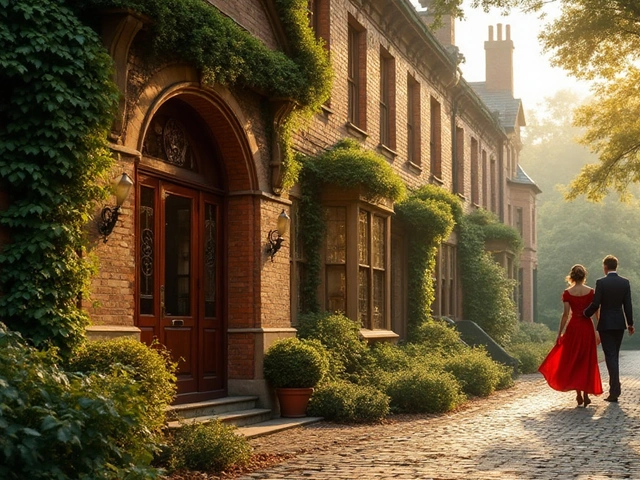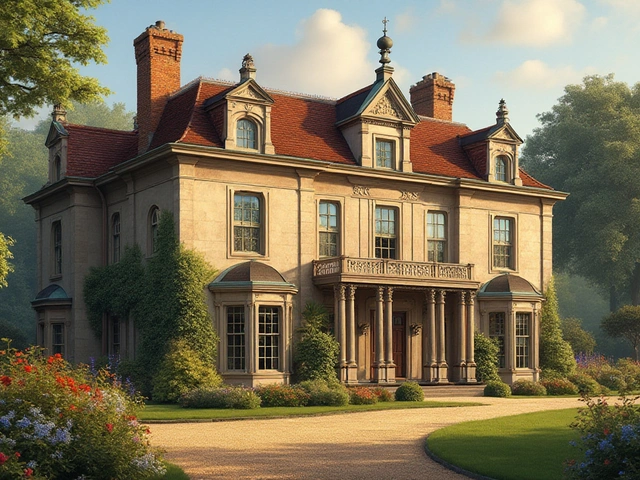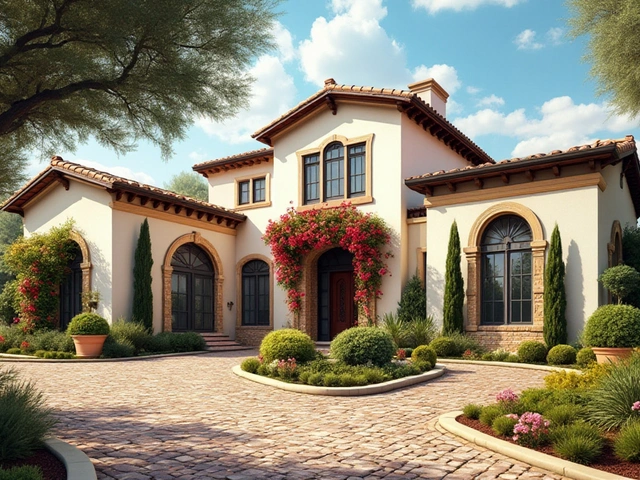Mediterranean Revival Architecture is like a sunbeam captured in bricks and mortar. It beautifully echoes the charming allure of the Mediterranean coasts, where warmth and history intertwine with nature's hues. Dating back to the turn of the 20th century, this style weaves together influences from countries like Spain, Italy, and Greece. It invites us to embrace a sense of peace and grandeur in our living spaces.
This architectural style is a dance of elegant curves and rich textures. It's not unusual to find yourself enchanted by the romance of terracotta-tiled roofs, the serenity of earth-toned stucco walls, or the whisper of a gentle breeze through arched doorways. Each structure tells a story of its rich heritage while seamlessly blending with the landscape.
As the world continues to change, the Mediterranean Revival finds new life in modern adaptations. Its timeless appeal offers a guide for those looking to create spaces that provide both beauty and harmony. Whether you're exploring ways to incorporate this beloved style into your architectural projects or simply seeking inspiration for your next creative venture, there's much to discover and cherish.
- Origins and Influences
- Key Features and Elements
- Notable Examples Around the World
- Modern Interpretations and Adaptations
- Incorporating Mediterranean Revival in Contemporary Homes
Origins and Influences
The story of Mediterranean Revival architecture unfolds in the late 19th century, a period marked by a growing fascination with the romantic allure of the Old World. This architectural renaissance took hold in America, particularly in warmer coastal regions such as California and Florida, where the climates mirrored that of traditional Mediterranean locales. Mediterranean architecture does not spring from a single source but is instead a compilation of influences from Italy, Spain, and even the Moorish regions of North Africa. These varied elements blend together to form a design that is not only aesthetically pleasing but also practical for sun-drenched environments.
Architects of the time were inspired by their travels and the grandeur of Mediterranean countries, thus seeking to recreate the serene beauty and relaxed atmosphere they experienced overseas. The revival tapped into the cultural melting pots of Greece, Spain, and Italy, drawing upon elements like the arched doors and windows of Italian villas, the red-tiled roofs reminiscent of Spanish colonials, and the ornate details found in Moorish palaces. This fusion aimed to evoke a sense of timeless elegance, wrapped in a nostalgic nod to classical grandeur.
Many iconic structures now symbolize this trend, including the glamorous Beverly Hills Hotel, adorned with lush courtyards and flowing fountains. In fact, the prominence of Mediterranean Revival became synonymous with luxury resorts and affluent residences. According to architectural historian Stefano Box, "The Mediterranean Revival style was a deliberate attempt to recreate the romance of the Riviera for American clients who longed for the warmth and sophistication of the Mediterranean coast."
The style was popularized at a time when America was experiencing rapid growth and newfound wealth. This booming economy facilitated the construction of opulent homes and public buildings that celebrated a cosmopolitan view of the world. Mediterranean Revival became a symbol of prosperity and worldliness, often chosen by those seeking status and cultural prestige. The global fascination with Mediterranean design is evident in its persistent adaptation and enduring appeal, weaving Old World charm into modern visions of architectural beauty.
The influences of historical design on modern Mediterranean Revival architecture can still be seen today. This style not only reflects a longing for the whimsy and romance of bygone eras but also remains versatile enough to be tailored to contemporary sensibilities. It stands as a testament to the timeless appeal of its varied influences, offering a narrative rich with tales of sunlit landscapes and architectural artistry.
Key Features and Elements
The enchanting appeal of Mediterranean architecture finds its resonance in a variety of distinct features, each contributing to the style's warmth and grandeur. These elements collectively create an atmosphere reminiscent of coastal Mediterranean regions where the architecture is as much a product of culture as it is the climate. One cannot overlook the iconic terracotta roof tiles, which, with their deep, rustic reds and oranges, gracefully age over time, giving each building a character that becomes more compelling with each passing season. The tiles are not merely decorative; they reflect the sun's intense rays, keeping interiors cool during the sweltering summer months.
The walls, often crafted from plaster or stucco, mirror the earth tones of the natural surroundings, contributing to a serene and cohesive aesthetic. These materials have the added benefit of being highly adaptable, allowing intricate designs and patterns that can turn even a simple façade into an artwork. Spanish and Moorish influences have led to the incorporation of arched windows and doors, their curves offering an elegant contrast to the otherwise linear forms of the buildings. These arches are not simply ornamental; they serve to frame the view and invite an influx of natural light, enriching the interior spaces.
Beyond these visible features, Mediterranean Revival homes often include majestic inner courtyards and lush gardens. These outdoor spaces are integral to the design, creating a seamless transition between the interior and exterior. In the words of celebrated architect Addison Mizner, "A house should blend with the landscape rather than stand apart from it."
A house should blend with the landscape rather than stand apart from it – Addison Mizner, ArchitectThe gardens are typically abundant with aromatic herbs and vibrant flowers native to the Mediterranean terrain, infusing the air with scents of rosemary and jasmine that weave stories of distant lands.
Attention to detail is evident in the use of wrought iron work, which often adorns balconies, gates, and railings. The intricate designs provide both security and beauty, their dark hues contrasting dramatically against the lighter tones of stucco or plaster walls. Additionally, hand-painted tiles are frequently employed to inject bursts of color and pattern into an otherwise subtle palette. These tiles are not just confined to floors but are often used in kitchens, bathrooms, and around fountains, each one a testament to the exquisite craftsmanship that Mediterranean architecture celebrates.
Inside, you will find rooms typically arranged around a central hallway or courtyard, a nod to the style’s emphasis on communal living and entertaining. Ceilings, often beamed with dark, heavy wood, evoke a sense of warmth and history. Large windows and French doors encourage the flow of light, allowing the transition from day to night to softly alter the atmosphere within. It is a style that truly celebrates open spaces and natural light, giving it a timeless appeal that continues to inspire architects and homeowners alike.
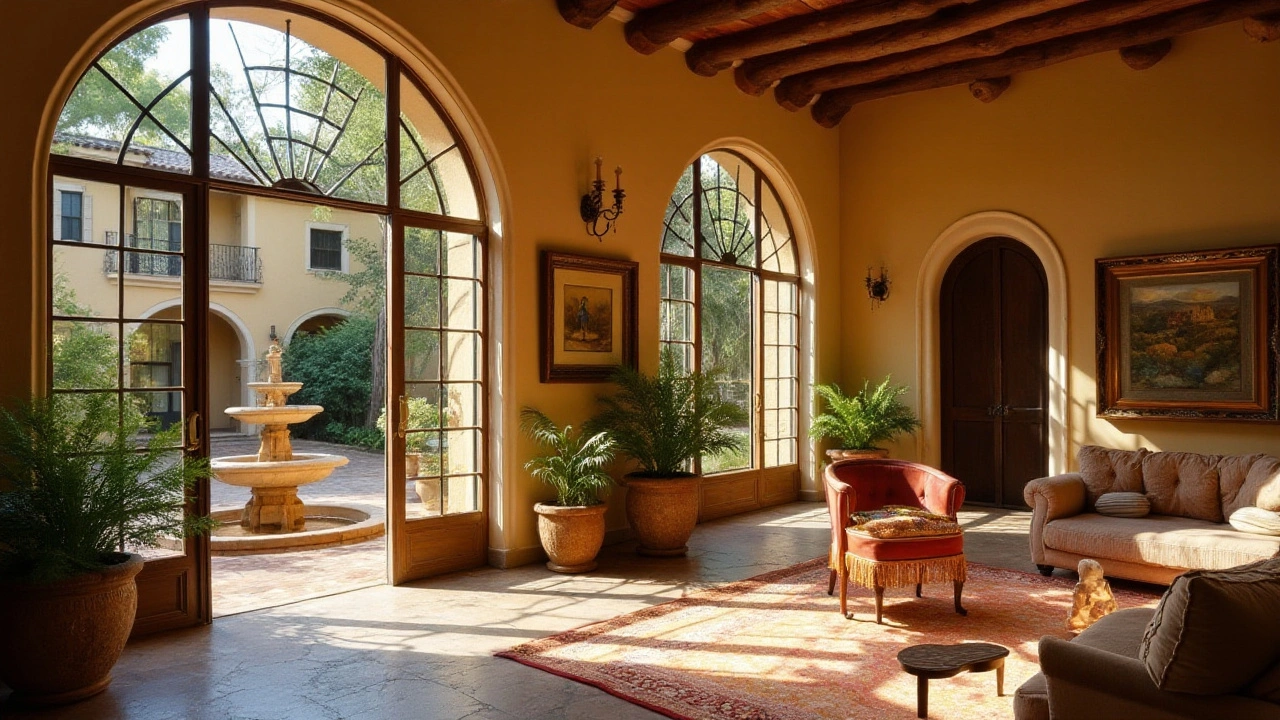
Notable Examples Around the World
When discussing the charm of Mediterranean Revival Architecture, it's impossible to ignore its most iconic representations spread across the globe. This architectural style, deeply influenced by the sunny shores and historical whispers of the Mediterranean region, has found its way into various parts of the world. It is not just the structure of the buildings that captivates, but also the culture and stories that surround each location.
One of the most significant places to explore this architectural style is in Southern California, particularly in Santa Barbara. The city has embraced the Mediterranean Revival aesthetic, with its red-tiled roofs and white stucco facades becoming a defining feature of the landscape. This was notably due to the influence of renowned architect George Washington Smith, who, inspired by Andalusian farmhouses, left a lasting legacy in the region with his masterful constructions such as Casa del Herrero.
Presiding over another continent, the Alhambra Palace in Granada, Spain, is a source of endless inspiration for many Mediterranean Revival designs. Although it's a traditionally Moorish construction, its profound intricacies and use of space have continuously fueled the creativity behind many modern imitators. The palace's mastery of light, alongside the intricate tile work and interplay of water features, offers a blueprint for those looking to evoke a sense of antiquity and elegance in new designs.
In the southeastern United States, particularly in Florida, the Mediterranean Revival style is synonymous with the opulence of the early 20th century. The famed architect Addison Mizner transformed Palm Beach with his imaginative interpretations of Spanish villas and Italian palazzi. The Everglades Club, a social and sporting retreat, stands as a testament to Mizner's vision of luxury interwoven with reconnections to European elegance. Residents and visitors alike find themselves walking through history, with each curve and courtyard echoing tales from the past.
"The influence of European architecture isn't simply about aesthetics; it's about bringing a way of life, leisure, and beauty into everyday existence." — Architectural Digest
Farther afield, the Shrine of the Báb in Haifa, Israel, offers another striking example of this architectural style’s reach and versatility. With its domed golden roof and symmetrically landscaped terraces, it captures both spiritual significance and architectural grandeur. Drawing crowds from all over the world, this landmark celebrates unity in design and underscores the timeless appeal of Mediterranean Revival architecture.
Today, the versatility of Mediterranean Revival architecture is beloved around the world for bridging the gap between nature and human ingenuity. By threading together historical significance, regional materials, and a sense of luxury, this style creates spaces that offer warmth and welcome. With such a vast array of inspirations, the Mediterranean Revival continues to enchant architects and dreamers worldwide, proving the enduring impact of its timeless beauty.
Modern Interpretations and Adaptations
The Mediterranean architecture style, with its timeless charm and romantic allure, has found its way into the hearts of modern architects and homeowners alike. Today, its legacy is apparent not just in nostalgic tributes to the past but in evolved designs that capture its essence in contemporary contexts. This modern reinterpretation hinges on a balanced blend of traditional elements with new materials and technologies, allowing it to thrive in various geographical locations and climates.
One key aspect of contemporary adaptations is the use of sustainable materials and energy-efficient design principles. Many new constructions feature solar panels hidden within the familiar terracotta roofing, offering both functionality and aesthetic integrity. The stucco walls still maintain their earth-toned warmth, but often utilize advanced insulation technologies to keep interiors naturally cool in the summer and warm in the winter, benefiting from the elements rather than fighting against them.
Open floor plans have become a staple in modern homes, and the Mediterranean Revival style adapts beautifully to this concept by embracing the airy spaces typically enclosed in older buildings. Walls are minimized in favor of large archways and expansive windows that invite natural light to dance across the floors. These architectural elements not only nod to tradition but also enhance the modern directive of creating harmonious indoor-outdoor living spaces.
"The fusion of Mediterranean aesthetics with modern functionality reflects a shift towards a lifestyle that values both beauty and utility," suggests architectural historian Dr. Elaine Harper, emphasizing how this classical style seamlessly integrates into our evolving world.
Incorporating smart home technologies further revolutionizes modern interpretations of this historical style. Smart lighting systems replicate the warm, golden glow that characterized traditional Mediterranean homes, while automated climate control systems maintain comfort efficiently and sustainably. Connectivity doesn't detract from the aesthetic; rather, it complements the design by ensuring that functionality matches the beauty of the architecture.
For those looking to renovate or build new homes while retaining the Mediterranean Revival spirit, there are key considerations to keep in mind. Choosing materials that complement the environment is vital; natural stone and reclaimed wood can enhance the organic feel of the structure. Implementing water features, such as fountains or pools, can echo the serene ambiance of the Mediterranean coastlines, offering a refreshing nod to its oceanic roots.
Lighting is also an important factor; using wrought iron fixtures and pendant lights can add touches of elegance, paying homage to the ornate detailing found in historic counterparts. Lush, curated gardens with native plants can provide not just aesthetic beauty but also promote local biodiversity and sustainability. Essentially, adapting this Mediterranean architecture to modern sensibilities requires a deep respect for its past, an understanding of present technologies, and a vision that is both forward-thinking and deeply rooted in its aesthetic heritage.
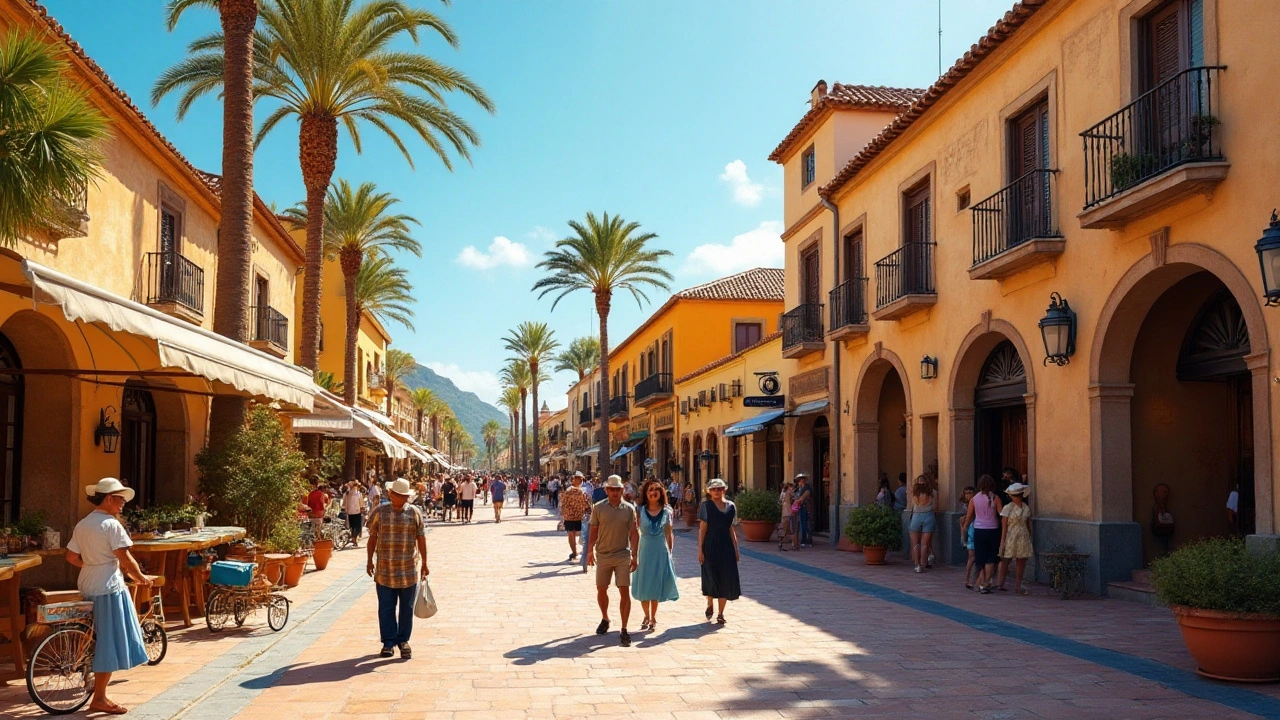
Incorporating Mediterranean Revival in Contemporary Homes
Bringing the charm of Mediterranean Revival Architecture into a modern setting is like capturing a gentle breeze from the distant coasts of the Mediterranean, allowing it to flow throughout your home. It starts with embracing the hallmark features, such as earthy stucco exteriors, red-tiled roofs, and harmonious color palettes. Step into the world where arched windows and doors transition seamlessly, soaking rooms in natural light reminiscent of a sun-kissed day. These structural elements create fluid spaces that feel airy and open, fostering a connection to the outdoor environment.
Inside, the texture plays a pivotal role. Using natural materials like wood beams on ceilings, terracotta or natural stone flooring, and wrought iron detailing brings warmth and a sense of rustic elegance. Often, simple additions such as handcrafted tiles or ornate fireplaces can evoke an Old World sensibility while providing modern practicality and comfort. This style isn’t about duplicating history but capturing its spirit and making it relevant to today's lifestyle.
When considering color, opt for those found in the Mediterranean landscape – think warm yellows, bright blues, and soft terracottas, all inspired by sun-drenched days and serene seas. These colors can invigorate an open-plan kitchen or create an inviting dining area perfect for entertaining. Bringing in lush greenery through potted olive or lemon trees, or setting up a Mediterranean herb garden can also enhance the natural feel typically associated with this style.
Incorporating outdoor living spaces is integral to the Mediterranean Revival style. Creating seamless transitions between indoor and outdoor areas often involves expansive patios or courtyards filled with fragrant climbing jasmine and vibrant bougainvillea, setting the perfect stage for al fresco dining in the warm embrace of twilight. Furniture choices should equally reflect this charm; wrought iron pieces and curved wooden furniture stand as timeless nods to a past where quality and craftsmanship were paramount.
"The beauty of Mediterranean Revival is its ability to transport homeowners to a place of solace and beauty, it's more than a style; it's a lifestyle," shared architect Joan Smith, known for blending traditional and modern elements in her designs.
The art of blending modern technologies and eco-friendly materials into these spaces without losing their traditional allure is crucial. Consider installing energy-efficient windows that still capture the signature arches or using reclaimed wood for new beams. This sustainable approach not only respects the planet but also maintains the unique aesthetic appeal that this style promises.
For a finishing touch, embrace ornamentation with an eye for balance. Whether through decorative fountains or intricate tile mosaics, allowing each piece to tell a story while enhancing functionality and beauty is key. By melding these elements into your contemporary abode, you can create a sanctuary that offers both the tranquility of a Mediterranean retreat and the functional elegance required for modern life.

